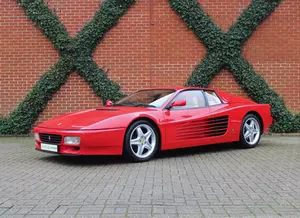
| Vehicle | Curb weight | Difference from world's smallest | Weight to power ratio | 0—60 mph acceleration ratio | Consumption ratio |
|---|---|---|---|---|---|
| F512 M |
1630 kg / 3594 lbs |
1205 kg (2657 lbs) heavier | 4 kg to 1 hp | 362 kg/s (798 lbs/s) |
104 kg/L (229 lbs/L) |
| Vehicle | F512 M |
|---|---|
| Curb weight |
1630 kg / 3594 lbs |
| Difference from world's smallest | 1205 kg (1205 lbs) heavier |
| Weight to power ratio | 4 kg to 1 hp |
| 0—60 mph acceleration ratio | 362 kg/s (798 lbs/s) |
| Consumption ratio |
104 kg/L (229 lbs/L) |

| Vehicle | Curb weight | Difference from world's smallest | Weight to power ratio | 0—60 mph acceleration ratio | Consumption ratio |
|---|---|---|---|---|---|
| 4.9 i V12 48V |
1590 kg / 3506 lbs |
1165 kg (2569 lbs) heavier | 4 kg to 1 hp | 346 kg/s (763 lbs/s) |
135 kg/L (298 lbs/L) |
| Vehicle | 4.9 i V12 48V |
|---|---|
| Curb weight |
1590 kg / 3506 lbs |
| Difference from world's smallest | 1165 kg (1165 lbs) heavier |
| Weight to power ratio | 4 kg to 1 hp |
| 0—60 mph acceleration ratio | 346 kg/s (763 lbs/s) |
| Consumption ratio |
135 kg/L (298 lbs/L) |

| Vehicle | Curb weight | Difference from world's smallest | Weight to power ratio | 0—60 mph acceleration ratio | Consumption ratio |
|---|---|---|---|---|---|
| 4.9 |
1499 kg / 3305 lbs |
1074 kg (2368 lbs) heavier | 4 kg to 1 hp | - | - |
| Vehicle | 4.9 |
|---|---|
| Curb weight |
1499 kg / 3305 lbs |
| Difference from world's smallest | 1074 kg (1074 lbs) heavier |
| Weight to power ratio | 4 kg to 1 hp |
| 0—60 mph acceleration ratio | - |
| Consumption ratio | - |